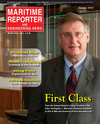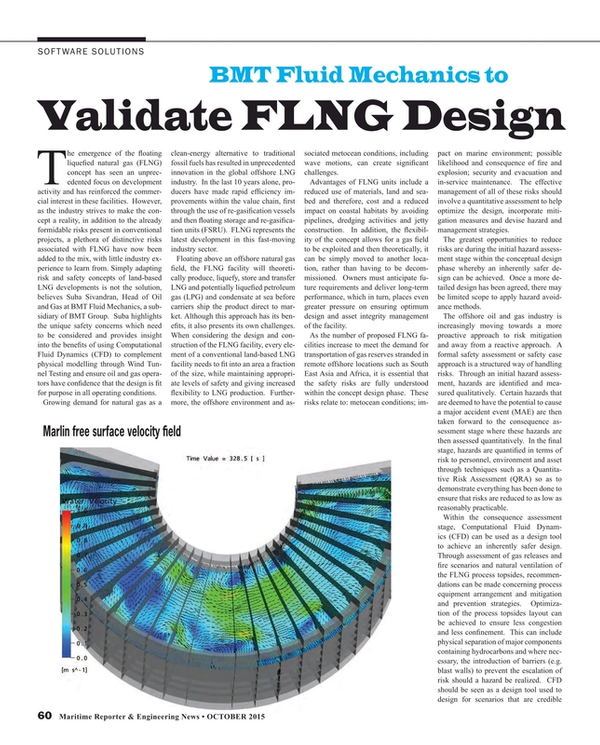
BMT Fluid Mechanics to Validate FLNG Design
The emergence of the floating liquefied natural gas (FLNG) concept has seen an unprecedented focus on development activity and has reinforced the commercial interest in these facilities. However, as the industry strives to make the concept a reality, in addition to the already formidable risks present in conventional projects, a plethora of distinctive risks associated with FLNG have now been added to the mix, with little industry experience to learn from. Simply adapting risk and safety concepts of land-based LNG developments is not the solution, believes Suba Sivandran, Head of Oil and Gas at BMT Fluid Mechanics, a subsidiary of BMT Group. Suba highlights the unique safety concerns which need to be considered and provides insight into the benefits of using Computational Fluid Dynamics (CFD) to complement physical modelling through Wind Tunnel Testing and ensure oil and gas operators have confidence that the design is fit for purpose in all operating conditions.
Growing demand for natural gas as a clean-energy alternative to traditional fossil fuels has resulted in unprecedented innovation in the global offshore LNG industry. In the last 10 years alone, producers have made rapid efficiency improvements within the value chain, first through the use of re-gasification vessels and then floating storage and re-gasification units (FSRU). FLNG represents the latest development in this fast-moving industry sector.
Floating above an offshore natural gas field, the FLNG facility will theoretically produce, liquefy, store and transfer LNG and potentially liquefied petroleum gas (LPG) and condensate at sea before carriers ship the product direct to market. Although this approach has its benefits, it also presents its own challenges. When considering the design and construction of the FLNG facility, every element of a conventional land-based LNG facility needs to fit into an area a fraction of the size, while maintaining appropriate levels of safety and giving increased flexibility to LNG production. Furthermore, the offshore environment and associated metocean conditions, including wave motions, can create significant challenges.
Advantages of FLNG units include a reduced use of materials, land and seabed and therefore, cost and a reduced impact on coastal habitats by avoiding pipelines, dredging activities and jetty construction. In addition, the flexibility of the concept allows for a gas field to be exploited and then theoretically, it can be simply moved to another location, rather than having to be decommissioned. Owners must anticipate future requirements and deliver long-term performance, which in turn, places even greater pressure on ensuring optimum design and asset integrity management of the facility.
As the number of proposed FLNG facilities increase to meet the demand for transportation of gas reserves stranded in remote offshore locations such as South East Asia and Africa, it is essential that the safety risks are fully understood within the concept design phase. These risks relate to: metocean conditions; impact on marine environment; possible likelihood and consequence of fire and explosion; security and evacuation and in-service maintenance. The effective management of all of these risks should involve a quantitative assessment to help optimize the design, incorporate mitigation measures and devise hazard and management strategies.
The greatest opportunities to reduce risks are during the initial hazard assessment stage within the conceptual design phase whereby an inherently safer design can be achieved. Once a more detailed design has been agreed, there may be limited scope to apply hazard avoidance methods.
The offshore oil and gas industry is increasingly moving towards a more proactive approach to risk mitigation and away from a reactive approach. A formal safety assessment or safety case approach is a structured way of handling risks. Through an initial hazard assessment, hazards are identified and measured qualitatively. Certain hazards that are deemed to have the potential to cause a major accident event (MAE) are then taken forward to the consequence assessment stage where these hazards are then assessed quantitatively. In the final stage, hazards are quantified in terms of risk to personnel, environment and asset through techniques such as a Quantitative Risk Assessment (QRA) so as to demonstrate everything has been done to ensure that risks are reduced to as low as reasonably practicable.
Within the consequence assessment stage, Computational Fluid Dynamics (CFD) can be used as a design tool to achieve an inherently safer design. Through assessment of gas releases and fire scenarios and natural ventilation of the FLNG process topsides, recommendations can be made concerning process equipment arrangement and mitigation and prevention strategies. Optimization of the process topsides layout can be achieved to ensure less congestion and less confinement. This can include physical separation of major components containing hydrocarbons and where necessary, the introduction of barriers (e.g. blast walls) to prevent the escalation of risk should a hazard be realized. CFD should be seen as a design tool used to design for scenarios that are credible while following a risk-based approach.
Wind tunnel testing can also help ensure we are designing for safety. Over the last six years we have carried out testing on seven FLNG designs to assist designers in understanding potential mean forces and moments acting on a FLNG vessel.
Wind and current measurements can be combined to determine heeling moments for a stability analysis and wind forces and moments are also necessary inputs to analyses of the mooring and thruster systems. Similarly, operations within the offshore industry are becoming more complex and riskier due to ship sizes and vessels finding themselves in close proximity of one another. As such, it is important to understand the aerodynamic proximity effects associated with side-by-side operations through the use of wind tunnel testing.
Wind tunnel testing and advanced techniques such as CFD can play an integral role in helping to refine the design of an FLNG vessel. CFD should never be seen as a replacement to physical modelling, but rather a complement and the key is being able to interpret and understand the results of theory and experiment.
Bringing the two techniques together, the risks surrounding helicopter operations, which present another common MAE in offshore oil and gas, can be greatly reduced by using CFD and wind tunnel testing. Two of the biggest impacts to helideck environmental conditions are turbulence and hot turbine exhaust. Wind turbulence generated from airflow over obstructions such as the process topsides and turbine exhaust can significantly increase the risk involved with helicopter approach and landing.
Standards such as CAP 437 Standard for Offshore Helicopter Landing Areas and NORSOK C-004 Helicopter Deck on Offshore Installations provide guidance and a prescriptive approach to Helideck Operations and Helideck Design. Using CFD and wind tunnel testing together we can optimise helideck location and determine the best compromise between conflicting requirements so as to identify helicopter operating limitations likely to be imposed due to turbulence, downdraft or hot gases. With the CFD model validated against the wind tunnel testing, we can then rapidly run simulations testing further scenarios and optimise the design such as estimating the likely helideck downtime.
Developing advancement and most importantly, commonality in the methodology that combines reliable testing and simulation-based prediction of 3D wind fields and forces acting on large scale offshore vessels and floating production systems is key. Such an approach will provide operators and designers of these structures with the opportunity to drive forward these designs with ever increasing reliability and efficiency.
In today’s current economic climate when it may seem tempting to take short cuts and save on capital expenditure, optimising design early on in a project can help to not only reduce risks to personnel, environment and asset but also reduce costs by avoiding conservatism.
A thorough approach to design and a clear understanding of the risks present to an FLNG project can also be used to increase confidence with investors and financial institutions. Taking a risk based approach to design will ensure there won’t be any nasty surprises further down the line.
(As published in the October 2015 edition of Maritime Reporter & Engineering News - http://magazines.marinelink.com/Magazines/MaritimeReporter)
Read BMT Fluid Mechanics to Validate FLNG Design in Pdf, Flash or Html5 edition of October 2015 Maritime Reporter
Other stories from October 2015 issue
Content
- Making Sense and Taking Risks: Human Behavior in the Shipping Industry page: 14
- Ergonomics@Sea page: 16
- The Cost-conscious Manager page: 20
- Black Market Refrigerants Pose Risk to Shippers page: 22
- Marine Firefighting at Sea: Training to Survive page: 28
- Unmanned Vessels: The Future is Now page: 34
- Foreship: New CFD Methodology page: 48
- SCANIA Expands its Engine Range for Marine Applications page: 50
- Towboat Honors Structural Engineer Dobson page: 54
- Ulstein’s X-BOW Turns 10 page: 55
- KVH Debuts mini-VSAT Broadband 2.0 page: 56
- BMT Fluid Mechanics to Validate FLNG Design page: 60
- Hard Problems Demand Soft(ware) Solutions page: 62


